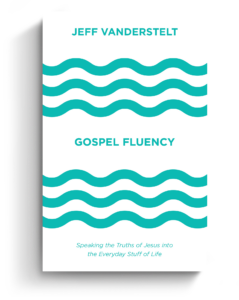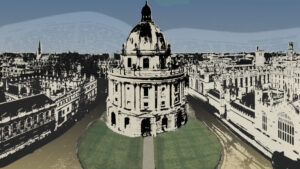I love novels. I especially enjoy the classics. I even love some contemporary fiction. I grew up reading fiction. And I studied it in college. Not everyone will share my passion for Russian and Scandinavian literature, but that doesn’t stop me from commending these treasures.
Sometimes, though, I meet Christians who never read fiction. Sometimes, I talk with Christians who could never imagine reading a novel. They’re even offended by such a waste of time when we could be reading the Bible and non-fiction works that edify believers.
How much more complicated, then, are the visual arts? Protestants today aren’t exactly known for our appreciation of this medium. I personally claim no expertise, with apologies to my one college course on art history. That’s why I’m so thankful to have Russ Ramsey as a docent in his new book, Rembrandt Is in the Wind: Learning to Love Art Through the Eyes of Faith. Ramsey is a pastor at Christ Presbyterian Church in Nashville, Tennessee, and a longtime friend of The Gospel Coalition.
If you’re like me, and you want to love art, but you don’t feel qualified, Ramsey’s book can help. “If you have not yet learned to love beauty,” he writes, “learn to love it late.” We’re made to achieve perfection, at least on the other side of glory, he says. Beauty is glimpsing a preview of that perfection in what we make here and now of goodness and truth. God didn’t need to make this world beautiful. He didn’t need to make humans in his image, concerned with goodness and truth. But he did, so that beauty might awaken us from spiritual stupor. Ramsey writes, “This is the mysterious, transcendent quality of art—something in the liniment oil and pigment breaks through the plain of the canvas and penetrates the human soul in a way that suddenly and inexplicably matters.”
Russ joins me on Gospelbound to discuss Rembrandt and Van Gogh, Kinkade vs. Caravaggio, why you need to learn the rules before you break them, and why a great painting demands as much as does reading War and Peace in one sitting.
Transcript
The following is an uncorrected transcript generated by a transcription service. Before quoting in print, please check the corresponding audio for accuracy.
Collin Hansen
Welcome to Gospelbound, a podcast from the gospel Coalition for those searching for resolute hope in an anxious age. I’m your host, Colin Hansen. And each week, I’m joined by insightful guests to talk about their written work and how the gospel applies to all of life. Together. We keep looking until we see God working. Wherever you’re listening. Welcome. I’m glad you’re here for today’s conversation. I love novels. I especially enjoy the classics. I even love some contemporary fiction.
Collin Hansen
I grew up reading fiction and I studied it in college. Not everyone will share my passion for Russian and Scandinavian literature. But that doesn’t stop me from commending these treasures. Sometimes, though, I meet Christians who never read fiction. Sometimes I talked with Christians who could never imagine reading a novel. They’re even offended by such a waste of time when we could be reading the Bible and nonfiction works that edify believers. How much more complicated then are the visual arts. Protestants aren’t exactly known for our appreciation of this medium.
Collin Hansen
I personally claim no expertise with apologies to my one college course on art history, which allowed by the way, that’s why I’m so thankful to have Russ Ramsey as a docent in his new book Rembrandt is in the wind, learning to love art through the eyes of faith, published by Zondervan reflective Ramsey is a pastor at Christ Presbyterian Church in Nashville, Tennessee and a longtime friend of the gospel coalition. Now if you’re like me and you want to love art, do you don’t feel qualified Ramsey’s book can help. If you have not yet learned to love beauty, he writes, learn to love it late. We are made to achieve perfection at least on this on the others on the other side of glory. He says, beauty is glimpsing a preview of that perfection in what we make here and now of goodness and truth. God didn’t need to make this world beautiful.
Collin Hansen
He didn’t need to make humans in his image concerned with goodness and truth. But he did so that beauty might awaken us from spiritual stupor. Ross writes, this is the mysterious transcendent quality of art. Something in the linen oil and pigment breaks through the plain of the canvas and penetrates the human soul in a way that suddenly and inexplicably matters. Ross joins me now gospel bound to discuss Rembrandt and Van Gogh. Kinkade and Caravaggio. Why you need to learn the rules before you break them. And why a great painting demands as much as reading Warren Piece in one setting. Russ, thanks for joining me.
Russ Ramsey
It’s good to be here. That was a fantastic introduction. My head is spinning.
Collin Hansen
Alright, let’s start this off. This is just really cool. Tell us the story of what happened to Rembrandt’s painting the Storm on the Sea of Galilee.
Russ Ramsey
In March of 1990, on St. Patrick’s Day, a couple of men dressed as Boston police officers hit the buzzer on the outside of the Isabella Stewart Gardner Museum in the Fenway neighborhood of Boston, the guards buzz them in then those two people dressed as police officers proceeded to tie those guards up and spend about an hour and a half, rounding up about 13 Priceless pieces of art, which they carried away into the Boston night. And those pieces have not been seen since one of them was Rembrandt Storm on the Sea of Galilee, which was cut from its frame.
Russ Ramsey
And so if you go to that museum now the Isabella Stewart Gardner Museum in Boston, the frame, that the Storm on the Sea of Galilee used to be in still hangs on the wall because of a kind of a rule in the Trust for that museum that if any of them use that the museum itself was a work of art. And that any of it if any of it was to was disturbed or changed, it would have to be added to or taken away. It would have to be liquidated and handed over to Harvard University. And so and so that frame hangs on the wall still to this day. And you can go to that museum and see where that painting used to be.
Collin Hansen
Yeah, what a story and you you talk in the book a little bit about what are you supposed to do with stolen art? And again, none of these has surfaced?
Russ Ramsey
Yeah, no, it’s been it’s been over 30 years, the FBI has had a $5 million reward for information leading to their discovery and they’ve gotten 1000s and 1000s and 1000s of leads, none of them usable or credible. So they’re just, they’re just gone. That’s where the title of the book comes from. It’s in the wind, that that Rembrandt painting. And, and gosh, I don’t. I don’t know, I don’t know if we’re ever gonna see it again.
Collin Hansen
Well, and you, which is part of the tragedy. And I think if I remember correctly from the book, one of the dynamics you play out is the benefactor of the museum. And he talks about tragedy in her life and the way she set up the museum as a sort of permanent display, you know, remembrance for all of time. But how this illustrates that, no matter what we want to preserve in this life, it is still in the wind.
Russ Ramsey
There’s a great there’s a great irony in in the, the, you know, she built a museum because she, because of her grief and loss of her son, and she wanted to build something that would endure something that would live, she said, my museum will live is what she said. And it’s interesting that the thieves cut that painting from the frame. Because Rembrandt painted himself into that painting. He’s in the middle of the boat, and he’s the guy who’s looking out at the viewer. And there had to have been a moment where the, the thief with the razor knife in his hand was eye to eye with Rembrandt, who was asking him the question that the disciples were asking Jesus in the boat is, and that’s Don’t you care that we’re perishing here? Don’t you care that this is the kind of world where this sort of thing happens. And, you know, it’s a curiosity to me, but it’s also a kind of a poignant thing to think about.
Collin Hansen
Well, what do you hang a print of Van Gogh’s self portrait with bandaged ear in your office?
Russ Ramsey
It’s funny, I look up right now. I’m touching it with my hand hanging on my office wall. So, you know, one of the if anybody knows anything about Van Gogh, one of the things they know is that he cut off his ear. It’s unfortunate that that’s the bit of information that we have. But I think it’s also kind of a general truism that, that it’s possible for us in life to be come known for the worst things we’ve done. And that to be the identity, you see that in the gospels, you know, what, here’s a woman caught in adultery, or, you know, people are identified by their affliction or by their sin.
Russ Ramsey
And he cut off his ear. And, uh, you know, it’s hard to know exactly why. Maybe it was some sort of epileptic related fit, or manic depression or something we don’t know. But the whole episode landed him in an asylum where he had to live for an extended period of time, back in those days, mental health was just kind of all mental health issues were all kind of just regarded, lumped together as madness. And so if you had depression, bipolar, schizophrenia, epilepsy, even it was all just madness, and they would put you in an asylum. And so here he is, and is in this asylum, recovering from wounds that he gave to himself, and what is the most shameful and low moment of his of his life, because he’s at the same time publicly known because of his art, but also publicly known because of his instability. And he paints this painting of himself with the bandage side showing, and he’s capturing his greatest moment of shame.
Russ Ramsey
And the irony is that the painting is worth more than anybody I know, could afford to, to pay for it, because it’s this priceless piece of art that is a, that captures the life in the in the struggle of Van Gogh, and I keep it in my office as a way of reminding myself of the kind of pastor that I want to be. And it’s the kind of pastor that doesn’t conceal my woundedness. But lets that side of me be seen by people, and encourages others to be willing to let that side of themselves be seen as well, because there’s, there’s beauty and letting our brokenness be seen by others. Because there’s a confidence there that our brokenness doesn’t define us. But it has. But but that Christ will heal it, and he’ll redeem those things. And so I keep it in my office to remind me of the paradox of we’re at the same time broken and have immeasurable worth. And that I want that kind of honesty to be how I approach my role as a pastor in a local church. So that’s why I’ve got it right there.
Collin Hansen
Love that story. Tell me how you became interested in art because I think for many of us, we didn’t grow up around high culture, paintings and sculpture, they, they feel intimidating, and I’d say even inaccessible, and short. We don’t really know what all the fuss is about. I grew up around paintings, but let’s just say that we’re more like Kinkade than Caravaggio. So how do you develop this passion?
Russ Ramsey
So I grew up in a small farming town in Indiana and a public school and I had a wonderful art teacher. who were artists themselves, but they really just cared about us learning to appreciate art and more, they cared about us just being in the presence of art that we took a lot of field trips to museums and, and but I had my art teacher in high school, one of the things that she said to us was, as she said, if you want to have a lifelong appreciation of art, you don’t need to go to college and be an art major, you just need to find an artists that you feel you connect with in some way. And then just pay attention to them for the rest of your life. You know, when you’re in a city and you go to a museum, go look and see if there’s anything by them there. And what will happen is, you’ll come to know a lot about them. And they’ll introduce you to their colleagues who hang on the wall next to them, they’ll introduce you to their mentors, the people who inspired them, and you’ll learn about artists who were inspired by that artist as well. And so So, you know, I’ve I found that to be a, the way that I connected with artists started with Van Gogh quickly spread to Rembrandt, and then and then others. And it’s funny, I’ve always been drawn to the artists, that my art teachers also loved. The ones that they would hold forth and say, these are great examples.
Russ Ramsey
You can’t go wrong, you know. So, Frank Lloyd Wright and Georgia O’Keeffe, were two of the ones that my art teacher, by the way, the book is dedicated to my art teachers from middle school in high school. And through the miracle of social media, I’ve been able to reconnect with them. And they sent me a photo of themselves together, they’re retired now, and the three of them got together, and they sent me a picture of themselves holding Rembrandt paintings in a frame that’s in my office. So yeah, I think about, you know, I think about the, the farmers that I grew up around, because I grew up really in farmland. And when I was writing this book, I was thinking, I want to write something that the farmers who lived down the street would read and appreciate. Which is not to say that the farmers didn’t have the capacity to appreciate art, it was that they were very pragmatic people who loved good stories. And that was that was kind of what I was aiming at the book is really a book of stories. More than anything else, the first chapter is a little bit of table setting. But then after that each chapter is very much a standalone story about a different artist or piece of art. And that was the goal was to tell the story behind these things in a way that that might help eliminate some of that intimidation, people feel.
Collin Hansen
It helped me. Somebody who fits that description, and a lot of those one of those ways that you’re describing there. This is one that this was a question that I that I had you answered in the book, we thought it’d be a good chance for you to tell us a little bit about it here. Why do so many biblical scenes from Renaissance art depict the characters and scenes as European?
Russ Ramsey
I love this question. So we live in it, we live in a cultural moment right now where we are global, we have access to images and people and cultural connections from all around the world at any given moment. But that has that hasn’t always been the case. And so you will find in a lot of cultures as the gospel spread, people would paint Jesus in the likeness of, of their culture. And so in European settings, he would be painted as European. I was actually just talking this morning with another pastor who spent some time in Tibet and saw a tapestry of of Jesus looking like a Buddhist monk. You see, you know, African depictions of Jesus, where he’s presented as a black man, you have these different cultures. And, you know, for us we get we get a little defensive about that, that because we know that Jesus was a first century Middle Eastern man, and that would have meant that he would have looked a certain way he certainly wouldn’t have been blond hair, blue eyes.
Russ Ramsey
However, there was an evangelistic goal in representing Jesus, according to the custom, or according to the, you know, the nationality of the artists that they were from as a way of saying, as the as the angel said to the shepherds on the hill, outside of, of Bethlehem unto you, a Savior has been born. And so, you know, we read it through a particular lens now, but but the, the, there was an evangelistic aim and presenting Jesus as one who was like the people who would be seeing those paintings as a way of helping them understand that that Christ came for you, you know, and, and so, you know, and also a lot of the, the European backdrops are simply because many painters then had never seen the Middle East. There weren’t photos there, you know, you know, and so they went with what they, what they, what they could see and were familiar with.
Collin Hansen
Oh, it’d be like, somebody painting the Earth from space. And I’m doing in the 19th century and you thinking, Boy, what an idiot you were, you didn’t know anything until realizing, you realize is maybe the most famous photo of the 20th century? Or the first time we’re seeing the Earth from space. Yeah, you just you don’t even know what you’re looking at. From the. So, yeah, you paint what you know. So many cases, I just love that. Love that story.
Collin Hansen
Because that’s a that’s a, I mean, a natural confusion point, I think at a time when any sort of classical movies we see are spoken with an English accent, with a British accent. So were rightly, I think, concerned about some of those aspects of cultural confusion and appropriation. But now, as I looked at these stories, great stories, and really most of them I didn’t know much about my just recently been to one of those new van Gogh exhibits, and also had been in in Amsterdam recently, but still didn’t know all the depths that you go into on these stories. But I wouldn’t exactly describe all the artists that you feature as models of Christian virtue, not what you were going for.
Russ Ramsey
Yeah, there’s no hagiography here, I know, these are not, these are not the biographies of saints. These are and what’s funny is going into it. I didn’t, I didn’t know what I was going to find, you know, some of these stories that are dark and and kind of land with a little bit of a thud. You know, the, the, you know, the redemption is in the wrongness of what we feel in the way the story is.
Collin Hansen
That’s what I was wondering, what do you want readers to see themselves in these artists in their work and that is partly what I what I appreciated, like what the chapter on Hooper, as an example of just like, did not end well.
Russ Ramsey
He was one I think about the Caravaggio chapter two, where Edward Hopper and Caravaggio were They were both pretty miserable people, and pretty caustic and abusive to those around them, and they’re in their art depicts a kind of a well, Hopper, his art depicts the kind of loneliness and desolation that the reason I wrote a chapter about him was because I was so drawn to the way that he makes this kind of loneliness feel so, so tangible, but getting into the story, it it wasn’t so much because he really wanted to fight against this loneliness and help people feel more connected.
Russ Ramsey
It was because he, he lived in that in that loneliness himself in a very caustic way, and kind of made people who are close to him also live in their own kind of loneliness, and a lonely in a lonely marriage. Yeah, and a lonely and a lonely marriage. It’s one of my favorite chapters in the book, because it is it it really is full of injustice, in ways that that that I still find myself trying to untangle the knot of what are we supposed to do with with a story like this one, Caravaggio was was the other one who, you know, he one of his biographer said Caravaggio only knew carnival and lent and nothing in between. He was either painting these incredibly transcendent, beautiful, biblical scenes that display just in their composition, a, some sense of, of comprehension of mercy, and grace and atonement and, and all of these things, but then we need to get the Commission needs ended on women and drinking and he’d go out carousing for months on end and murdered people in the process had to stay on the lamb for most of his adult life, trying to outrun people who were trying to have him put to death for his crimes.
Russ Ramsey
And, and what fascinated me about that story is, is I see myself in that I see, I see all of us and as a pastor, that we all are these paradoxes, of corruption and grace that we turn ever so earnestly to our need for atonement and redemption. We say things like the, like the apostle, you know, when Jesus said, Are you going to leave to where else am I supposed to go? And yet at the same time, we have this incredible capacity to, to sin against the Lord, to do damage in our relationships to do you know, to, you know, hurt ourselves in the process. And and so his his story was, was strangely encouraging to me that, that, that that, that we can we can trust that there is hope, for we who are these living paradoxes of, of corruption and Grace at the same time.
Collin Hansen
I think a lot of the ways we understand art now is fundamentally transgressive. And more or less, it’s got to be something different. It’s got to be something unusual. I think we, you know, we associate artists with the anti war halls of the world. There’s a A strong sense of irony, I would say in what they’re trying to do. But I find pastorelli when I’m counseling when I’m kind of setting vision for different things that almost always come back my background is more music than visual arts. But I always come back to what I tell people all the time. If you want to learn to improvise, you gotta learn scales first. That’s the rule. First of all, first rule of jazz. And I love what you say here that artists need to master the rules of composition, if they’re going to break them. Tell a little bit more about that. And that implications more broadly out of life or if I’m need to stop that line.
Russ Ramsey
Yeah, no, that’s, that’s something that you see over and over again, there’s the there’s a Picasso that hangs in the I think it might be the met in New York City, where it’s a doctor at a girl’s bedside. And it’s, it says realistic painting, as you’ll ever see. It looks like it could have been done by any of the Romantics, you know, and, and, and you see it and when you one of the things that’s so jarring about it is when you see Picasso’s name next to it, and you think that doesn’t look like a Picasso. Yeah, but what do you but it was, it was an early work of his, but what he’s showing us is he knew he knew how to paint people, he knew how to, he knew how to create a scene that was as good as anything else anybody was doing.
Russ Ramsey
And in order for him to create what he what he, you know, the Cubist stuff that he ended up doing, that everybody kind of knows him for, he had to know how to do it right, in order to how to break those rules in a way that would not look like complete chaos and disorder. And you see that with with all of these painters, there’s there’s a story, I think it’s in the war of art that Steven Pressfield book, where he talks about a college professor who had a pottery class, and he told his students your grade, you can choose how you get your grade, you can get your grade based on tonnage, you know, how much pottery can you make in this class, if you make this many pounds, you get this grade, make this many pounds, you get this grade, or you can turn in one piece, and be graded solely on that one piece. And you can have the entire semester to just make your one piece. And what he what he found was that the students who went the direction of sheer tonnage, made better pieces. And it it was because they have repetition.
Russ Ramsey
And it was because they just kept going and going and going and, and they didn’t have the time to stop and get myopic about the, you know, crafting this perfect piece, what whereas the other person would have been just all up in their up in their head. But it’s one of the things you see over and over again with these artists is that there’s a discipline to the craft, that you practice, and you drill on and you and you keep, keep doing it. And that is unto the end of some of these things that now hang in museums, but so much of life is that way, right? I mean, so much of ministry is I mean we even talk about the Christian life is something we practice. And I take that to be quite literally like we practice it like you would practice an instrument or you would practice a sport. That prayer is something we practice the more we do it the better we get at it if if you can say that about prayer, you know that there’s there becomes a we go from being unfamiliar to being intimate with these disciplines of of reading scripture and praying and even learning how to be part of a congregation part of the body of Christ, you know that these are things that don’t just automatically happen when you walk in the room, you can do them when you walk in the room. But as you practice them, you find a greater a greater joy and familiarity with them.
Collin Hansen
For some reason, I think a lot of Christians today, associate auth what they think of authenticity as the pinnacle of experience. And they think that if you work hard at something, it must not be authentic. It like authenticity comes along with sort of natural expression, more or less. And I think that’s a good observation that you bring out in the book is that these artists didn’t just sort of sit around and wait for inspiration and then realize it on the canvas but especially in the chapter on the lens in there it’s I mean, this is this is difficult work. I mean like we I think we gather that when we see Michelangelo’s David but sometimes we assume that people who are good at something just must be naturally gifted at that needs people are obviously gifted but what the classic works only come when it’s the combination of that giftedness with serious dedication, not to mention then also opportunity.
Russ Ramsey
Yeah, I mean there’s there’s no way around it and we really whatever the craft is that we work on, or whatever the thing is, we practice we also stand on the shoulders of people who have come before us who have Created ways for us to be able to do the things that we’re trying to do in order to show show our inspiration and our authenticity.
Russ Ramsey
You know, like even now we’re, we’re talking through laptops and microphones, you know, in in well lit rooms, because people invented, you know, light bulbs and all of the above all of the above and, and even for painters, you know, that the somebody had to weave the canvases and somebody had to make the brushes and somebody, there’s a part in the book where I talk about the invention of the tin paint tube was interesting, and how it just changed, it changed art, like you can go into a museum and the early 1800s art looks one way. And from the mid 1800s on it looks another way. And the reason it looks Another way is because of this invention of the paint tube, where painters weren’t shackled to their interior studios where their paint was, but they could throw it all in a duffel and go outside with their easel and paint outside. And what happens is, you see it with Impressionism.
Russ Ramsey
You see it with all these, all that all the French paintings of the mid 1800s, that there’s just this brightness that all of a sudden appears at a certain point in time. And it’s, you know, largely because of, of the portability of the medium that came about, there’s a Van Gogh painting that was found, somebody found a grasshopper leg. In the painting, there was an article about it online, we’re just painting outside and a grasshopper got stuck to it, you know, and the leg is still there. Colin, if I can find that article.
Collin Hansen
I like it would be fascinating there. Explain what you mean, that a great painting will demand as much from you as reading Warren Piece in one sitting. That’s not just hyperbole.
Russ Ramsey
I think that art is a it’s a dialogue. And so when you stand in front of a painting, the artist is talking to you, and you’re responding to the artist. And I think that if we want to be people who art is a part of our lives, what it’s going to require of us is learning how to read a certain language, a visual language, and it really is kind of a language with some vocabulary where you start to learn, okay, the use of this extreme contrast of light and dark that you see in Rembrandt or Caravaggio is not just for aesthetic purpose, but it’s for narrative purpose. It’s supposed to help us know what to look at first, and where our eyes are supposed to go next.
Russ Ramsey
And all that stuff kind of happens voluntarily or involuntarily, but But it’s, it’s that when you look at a painting, you’re not just looking at an image, but you’re reading a scene that has been captured in a particular moment like Rembrandt’s the sacrifice of Isaac is a great example of this, where when you see that painting, he captures a moment and so the artist is in complete control over which moment is he going to capture in order to tell the story. And it’s a moment where the knife is in midair, like, like the angel has showed up and told Abraham not to sacrifice his son. He’s got his hand kind of roughly on his son’s kind of neck. And, and the, and the knife is in midair, because he’s dropped it. And there’s, there’s, that’s a scene that we know, something like that would have happened in that story. But remember, it’s telling us something by making that the moment that he tells he’s telling us something about the urgency about the relief about the obedience of Abraham and and his trust, about the 11th hour nature of how God often shows up in our lives when we’re when we’ve been asking him for something forever.
Russ Ramsey
And so there’s art will reward us if we take time to slow down in front of it. You know, there’s a section in the book about how to visit an art museum, I wrote a couple of very practical sort of appendices, how to look at a piece of art and how to visit in an art meet an art museum because I think we make a mistake if we go to an art museum thinking, man, I’ve got six hours to do the Louvre, you know how it’s let’s just abandon hope all ye who enter here, you know, like, instead, pick what you’re going to look at before you walk in the door. You know, for me, I’m going to go see Rembrandt and I’m going to see Van Gogh. And there may be some people along the way that catch my eye or or I may go to a museum because it has a particular work of art that I’m I’m bent on seeing and and I’ll give those I’ll kind of prioritize the time. But I think, you know, that’s, that’s part of the way that we that we have to read art is we have to say, I can’t just digest everything, and there’s no time for that. And so, so we have to we have to pace ourselves and we’ll kind of learn learn vocabulary, read the plaque on the wall, but also learn a little bit of, of stillness and be okay with saying I don’t I don’t know that I get everything that’s going on here. Because you don’t have to in that moment.
Collin Hansen
If listeners could go to one Art Museum, which one should it be?
Russ Ramsey
I would say, either the met in New York City or the Chicago Art Institute. Oh, the Art Institute of Chicago. Those would be the two now. Those are, you know, in America, obviously, I think if I think if you could go anywhere in the world, I’d go to the Louvre and start maybe there but, but yeah, the Chicago artists who was the one that my art teachers took me to as a kid, and so I have an affection. Van Gogh’s bedroom is there surrogates Saturday afternoon in the park? Is there? Edward Hopper’s Nighthawks? Is there there’s some really amazing Grant Wood Of course, yeah, Grant Wood is there. So I just did an art Wednesday on him not that long ago on that painting.
Collin Hansen
Yeah, classic Midwestern art right there. I’ve been both places have been Chicagoans to longtime to the Met not too long ago. And they both met and MoMA just amazing. They’re in New York. Now, how does this? You’ve alluded to this a couple of different times. But how does this interest in the visual arts relate to your work as a pastor? Because I think it’s pretty clear in this book, you’re not using this art really, for evangelism or apologetics? That’s not the read that I get in the book, though I did, of course, see the preacher in you come out and your fascinating comparison between Van Gogh and the striving man of Ecclesiastes. But I didn’t see how do these relate?
Russ Ramsey
Well, I think it’s funny. I’ve I’ve had a few people asked me, generally the question, What is your relationship with art heft? How does that connect with your work as a pastor? The more I think about the question, the more I think, I think we have a problem here. If the question is, what does art have to do with ministry, that’s, that’s problematic. Because I, I, first, my love of art and my desire to be in the presence of visual art and to learn from it and engage with it preceded my pastoral, since my sense of pastoral call. And so that was part of what was built into this Midwestern kid before before seminary was even a word I knew. But I think if we want to understand God, let alone teach God, teach about God to other people. And we’re not cultivating interaction with things that move us to awe and wonder and the feeling that we’re that we’re in the presence of glory, then we’re going to give a very incomplete picture of God, I’m part of a, you know, a denomination in a theological circle, that, that, that can we can be known for being very heady, and very precise academically, and having a lot of complicated words and systematic theology that just can be like, you know, you know, Teflon, you know, and watertight and. And yet, I think, I think, wanting to give people a sense of, of who God is, if there’s not a pursuit of beauty and wonder and the ache that we feel to be in the presence of glory, and perfection, then we might fall off onto the side of just our ministry just being maybe an academic exercise.
Russ Ramsey
And so art has been very useful for me as a pastor because I don’t use it a ton in sermon illustrations, there are times when I will. But our church is filled with reproductions of Carvel shoe and Rembrandt and Van Gogh and Monet, when we designed the space that we moved into this past November, one of the things I did is we have about 20 reproductions of famous works of art with little plaques on the wall next to it because I, I want to kind of arrest the senses with these visual stories of of the pages of Scripture. But God himself is inherently beautiful. He’s inherently glorious. One of the things that Scripture tells us about him over and over a descriptor is glory. And and I think art in the creative process is one of the ways that we as human beings, since since creation have have sought to engage that part of not only who he is, but who we are as people made in His image. So I think it’s just a vital part of the pursuit of knowing God in the first place.
Collin Hansen
I love that talking here with Ross Ramsey. In his new book Rembrandt is in the wind. I just like saying that Rembrandt is in the wind. Rembrandt is in the wind learning to love art, through the eyes of faith. It’s new from Zondervan reflective. I’m going to do a final three. And if you feel like going back to your old What did you learn in the book you can Just you know, inserted in there. Okay. All right, we’ll do a final three. First, where do you find calm in the storm? I always ask this question, but it seems especially appropriate. If people know the Storm on the Sea of Galilee story was starting off with
Russ Ramsey
I find calm and the storm through physical activity going for a walk. I’m not what you might call an athlete, but I love taking long long walks and hiking and it is a it resets me. So that would be going to, I’ll go for a four mile walk any day of the week. Oh,
Collin Hansen
I love that format. That’s usually my length as well. Those are nice. So nice walks. What do you find good news today?
Russ Ramsey
Where do I find good news? I find good news in everyday conversations with people around me. That’s That’s it when I talk to my team that I work with here at the church, my family. That’s that’s where I find it.
Collin Hansen
Got any other other people who share these passions? In your church? on staff?
Russ Ramsey
Oh, yeah, well, not not not the they all kind of look at me as the art guy. Which, which I’ll take and I understand. And yet at the same time, yes, there’s a there’s a depth of, of, we have a lot of fun around here. Everything I have, my entire team is made up of people who find everything interesting. And that’s, that’s a gift for me for sure.
Collin Hansen
Look, one of the great virtues I think of especially this era that gives you such a perspective on many things is just curiosity. Just a wonder the difference between a Christian who is curious versus not, is often difference in many different, a kind of exemplars of the spirit of the fruit of the Spirit. And just sort of a posture toward other human beings. For other people, when you’re curious about God, curious about life, nothing curious about other people, which makes you loving, and kind and gentle toward them.
Russ Ramsey
The thing I found most interesting in this book is that, without exception, every artist that I learned about and wrote about was creating art in order to figure out what they believed about how the world worked, none of them, none of them were coming with a Realized vision and philosophy that they were intending to assert through their art, their art was their way of trying to figure it out, and find their way. And so one of the things that was fascinating to study in each of their lives, was not just looking at this painting or that painting, but looking at the body of work, and being able to see not sometimes progress toward health, sometimes to see a descent into mania. But but all of them their art was not to declare what they had already arrived at, but was instead to try to figure out what was good and true and beautiful.
Collin Hansen
That’s so fascinating, because the very nature of the art you’re describing is that it’s static. It has a moment in time. Yet it’s produced by men and women who are in progress, process, sometimes progressing, but sometimes regressing as well. Sometimes it’s leading to a happy ending. But, of course, most famously, Van Gogh never has that happy ending. Last question. What’s the last great book you’ve read?
Russ Ramsey
The last great book I’ve read was, I just read a I’m in my element here. I just read a biography of Rembrandt. Okay, that by Helga Kunzel is her name. And it’s, it’s, it’s a short little book about about the arc of his life story. And it was a it was a fascinating, fascinating read.
Collin Hansen
Okay, right on theme, read on theme. My guest here, gospel bound this week has been Russ Ramsey. Check out his new book Rembrandt is in the wind learning to love art through the eyes of faith from Zondervan reflective for us. It’s been a joy. Thank you. Thank you. Thanks for listening to this episode of gospel bound. For more interviews and to sign up for my newsletter. Head over to tgc.org/gospel bound rate and review gospel bound on your favorite podcast platform so others can join the conversation. Until next time, remember, when we’re bound to the gospel, we are bound in hope
“The Most Practical and Engaging Book on Christian Living Apart from the Bible”
 “If you’re going to read just one book on Christian living and how the gospel can be applied in your life, let this be your book.”—Elisa dos Santos, Amazon reviewer.
“If you’re going to read just one book on Christian living and how the gospel can be applied in your life, let this be your book.”—Elisa dos Santos, Amazon reviewer.
In this book, seasoned church planter Jeff Vanderstelt argues that you need to become “gospel fluent”—to think about your life through the truth of the gospel and rehearse it to yourself and others.
We’re delighted to offer the Gospel Fluency: Speaking the Truths of Jesus into the Everyday Stuff of Life ebook (Crossway) to you for FREE today. Click this link to get instant access to a resource that will help you apply the gospel more confidently to every area of your life.
Collin Hansen serves as vice president for content and editor in chief of The Gospel Coalition, as well as executive director of The Keller Center for Cultural Apologetics. He hosts the Gospelbound podcast and has written and contributed to many books, most recently Timothy Keller: His Spiritual and Intellectual Formation and Rediscover Church: Why the Body of Christ Is Essential. He has published with the New York Times and the Washington Post and offered commentary for CNN, Fox News, NPR, BBC, ABC News, and PBS NewsHour. He edited Our Secular Age: Ten Years of Reading and Applying Charles Taylor and The New City Catechism Devotional, among other books. He is an adjunct professor at Beeson Divinity School, where he also co-chairs the advisory board.
Russ Ramsey (MDiv, Taylor University; ThM, Covenant Theological Seminary) is a pastor at Christ Presbyterian Church in Nashville, Tennessee, where he lives with his wife and four children. Russ is the author of several books, most recently Rembrandt Is in the Wind: Learning to Love Art through the Eyes of Faith and Van Gogh Has a Broken Heart: What Art Teaches Us About the Wonder and Struggle of Being Alive.

































